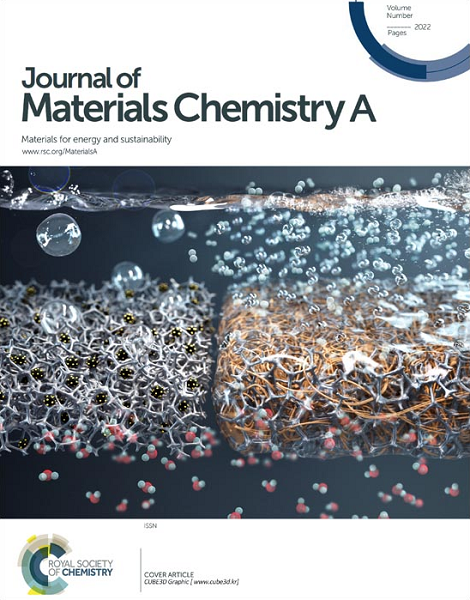用于高效气体分离的界面集成混合基质膜的机械化学处理
IF 10.7
2区 材料科学
Q1 CHEMISTRY, PHYSICAL
引用次数: 0
摘要
混合基质膜(MMMs)是由纳米多孔填料和聚合物混合而成的膜,具有巨大的节能分离潜力,为解决困扰聚合物膜或纯纳米多孔膜的渗透选择性权衡、放大和老化问题提供了理想的平台。然而,实现真正的相间集成来设计高性能mm仍然极具挑战性。在本研究中,利用机械化学方法构建了基于金属-有机框架和本征微孔率-1聚合物的界面集成mm,用于高效气体分离。表征和分子动力学模拟表明,通过简便、可扩展和通用的球磨机械化学处理可以破坏填料表面的晶体周期性,形成无序界面,促进填料中聚合物的插入和填料与基体的集成,从而大大提高填料的分散性、界面相容性、分离性能和抗老化性能。经过220 d自然老化和变湿变温操作,界面集成mm的CO2和CH4渗透率以及CO2/N2和CH4/N2选择性分别达到18400和1500 Barrer, 32.1和4.0,轻松超过最小性能上限。可以设想,这里报道的这个概念提供了另一种途径,以实现所需的性能和最大化的分离性能的mm。本文章由计算机程序翻译,如有差异,请以英文原文为准。
Mechanochemical processing of interface-integrated mixed-matrix membranes for efficient gas separations
Mixed-matrix membranes (MMMs), those hybridized by nanoporous fillers and polymers, hold great potential for energy-saving separations and offer ideal platforms to address permeability-selectivity trade-off, scale-up, and aging issues that plague polymer membranes or pure nanoporous membranes. However, achieving truly interphase integration to design high-performance MMMs remains extremely challenging. In this study, mechanochemistry is employed to construct interface-integrated MMMs based on metal-organic frameworks and polymers of intrinsic microporosity-1 for efficient gas separations. Characterizations and molecular dynamics simulation demonstrate that mechanochemical processing via facile, scalable, and versatile ball milling can disrupt crystalline periodicity of filler surfaces to form disordered interfaces and promote polymer-in-filler insertion and filler-matrix integration, thereby substantially enhancing filler dispersity, interfacial compatibility, separation performance, and antiaging property of MMMs. After natural aging for 220 days and humidity/temperature-swing operations, the CO2 and CH4 permeability and CO2/N2 and CH4/N2 selectivity of the interface-integrated MMMs are still achieved up to 18400 and 1500 Barrer and 32.1 and 4.0, respectively, which easily outclass the least performance upper bounds. It can be envisaged that this concept reported here provides an alternative route to achieve the desired property and maximize the separation performance of MMMs.
求助全文
通过发布文献求助,成功后即可免费获取论文全文。
去求助
来源期刊

Journal of Materials Chemistry A
CHEMISTRY, PHYSICAL-ENERGY & FUELS
CiteScore
19.50
自引率
5.00%
发文量
1892
审稿时长
1.5 months
期刊介绍:
The Journal of Materials Chemistry A, B & C covers a wide range of high-quality studies in the field of materials chemistry, with each section focusing on specific applications of the materials studied. Journal of Materials Chemistry A emphasizes applications in energy and sustainability, including topics such as artificial photosynthesis, batteries, and fuel cells. Journal of Materials Chemistry B focuses on applications in biology and medicine, while Journal of Materials Chemistry C covers applications in optical, magnetic, and electronic devices. Example topic areas within the scope of Journal of Materials Chemistry A include catalysis, green/sustainable materials, sensors, and water treatment, among others.
 求助内容:
求助内容: 应助结果提醒方式:
应助结果提醒方式:


